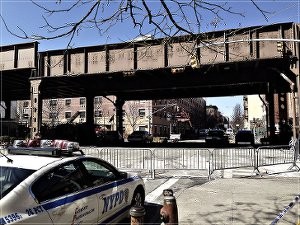Public hearing demanded for 2014 East Harlem explosion
One year ago on March 12, a horrendous explosion in East Harlem killed eight people and injured many more. For the victims of the blast who survived, the passing of time has not dulled the experience.
Many still suffer physically and emotionally from the impact of the explosion, which demolished two five-story apartment buildings just north of 116th Street. The two buildings together, 1644 and 1646 Park Ave., contained 15 residential units, plus an evangelical church and a piano store.
The terrific blast also impacted surrounding buildings and businesses. The city’s Comptroller’s Office has received over 200 notifications that people intend to sue for charges ranging from wrongful death to property damage. Residents of one nearby building, 1652 Park Ave., have formed a tenants’ association as a result of the explosion.
The National Transportation Safety Board conducted on-site testing following the explosion, and is now continuing to investigate the cause of the blast. Testing at the site revealed that Consolidated Edison pipelines dated back over 100 years.
New Yorkers in Solidarity with the Victims and Community of East Harlem is an ad hoc group of tenant and environmental activists mobilized by community organizer Johnnie Stevens. This group has requested that the NTSB use its authority to call a public hearing in East Harlem so that community residents and small businesses may determine what aid is needed and what must be done to prevent such a disaster and accompanying displacement from recurring.
The group delivered 620 signed petitions to the NTSB supporting the call for a public hearing.
The danger of gas-related explosions continues to plague New York as well as the rest of the country. There are tens of thousands of cast iron and steel gas mains lurking beneath U.S. cities and towns. These pipes have been a long-time target of government regulators and safety advocates as well as NTSB accident investigators.
The New York-based Center for an Urban Future reported that New York’s aging infrastructure “could wreak havoc on the city’s economy and quality of life.” (nycfuture.org, March 2014)
A pipeline under New York’s densely populated Greenwich Village and Chelsea communities won approval by the Federal Energy Regulatory Commission despite concerns by community organizers and activists. They fear an explosion could occur if the pipes distributing gas to Con Ed’s Manhattan customers were damaged.
The Sane Energy Project, a group opposing the pipeline, also cited fears of radon, a chemical element found in the gas that can cause lung cancer.


